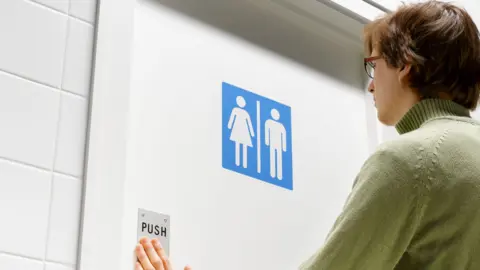The Equalities and Human Rights Commission (EHRC) has recently issued interim guidance that directly addresses the implications of a landmark ruling by the UK Supreme Court, which clarified the legal definition of a woman as being based on biological sex rather than gender identity. This decision has far-reaching effects on various organizations, especially concerning the use of single-sex spaces in public facilities such as hospitals, shops, and restaurants.
The EHRC’s interim guidance stresses that trans women, defined as individuals assigned male at birth but who identify as female, should not be allowed to access women’s facilities. Conversely, the guidance emphasizes that it is essential to ensure that trans individuals are not left without adequate facilities. This dual obligation seeks to balance the need for single-sex spaces with the need for inclusivity, essentially recognizing the complexities surrounding gender identity while adhering to legal definitions that the Supreme Court has clarified.
In the recent court ruling, justices determined that the terms “woman” and “sex” in the 2010 Equality Act refer specifically to biological designation. This legal interpretation means that transgender women, being biologically male, may be excluded from women-only spaces without infringing upon their rights. Judge Lord Hodge indicated during the proceedings that existing laws still protect transgender individuals from discrimination, highlighting the challenging interplay between gender identity and legal definitions.
The EHRC wants to ensure that affected organizations, including schools and associations, understand the implications of this ruling. For example, the guidance uniquely notes that in educational settings, pupils identifying as trans girls (biological boys) should not use girls’ restrooms or changing rooms, and similarly, trans boys (biological girls) should not use boys’ facilities. Schools may need to implement alternative arrangements to accommodate all students appropriately.
In associations, which include clubs or groups having over 25 members, the EHRC posits that women-only or lesbian-only groups should not allow the admission of trans women. Similarly, men-only or gay men-only associations should not include trans men. Essentially, the guidance seeks to reinforce the notion of single-sex spaces while also recommending that wherever possible, mixed facilities be provided to ensure all individuals have access to suitable options.
In premises with facilities available for both sexes, the guidance reiterates that provision must be made for trans individuals to use facilities without compromising the single-sex designation. This could be achieved through the installation of more mixed-sex toilets or ensuring that single-user restrooms exist that can be locked and used by only one person at a time. For instance, a single toilet at a café could serve as a viable solution for such arrangements.
A critical aspect of the interim guidance is that it aims to clarify the impact of the Supreme Court’s ruling on various stakeholders, urging employers and duty-bearers to comply with the law while also seeking specialist legal advice when necessary. By doing so, the EHRC hopes to facilitate a smoother transition into adapting practices that comply with the new legal realities.
Additionally, the EHRC plans to solicit feedback through a consultation expected to launch in May, allowing affected stakeholders to voice their concerns and suggestions. The objective is to create an updated code of practice that aligns with the latest legal requirements, aiming for governmental approval by late June.
A government spokesperson has welcomed the court’s decision and the clarity it provides for women and service providers, stating they will evaluate and refine policies to ensure compliance with the new legal standings. Overall, while the ruling appears to bring a degree of clarity regarding the usage of single-sex spaces, its implementation complicates the historical integrity of transgender rights, thereby igniting further discussions on gender identity within legal frameworks. This juncture reflects society’s ongoing exploration of equality, rights, and the multifaceted nature of identity.



